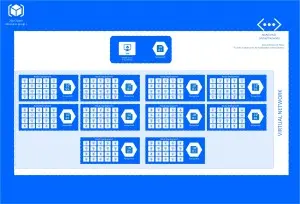
The cloud is one of the biggest changes in our industry and it has impacted all of us. Cloud is the latest symptom of a general trend towards more open, collaborative ways of working where companies become much less self-sufficient “islands” of activities than they were in the bygones.
From my point of view, businesses require extreme agility and the cloud can help organizations to achieve that level of agility.
Cloud Automation – A driving force in Data Centre Automation
A business leveraging cloud automation solutions can spend more time in creating forward-thinking initiatives and innovative policies and products. By better allocating resources, firms can more effectively position themselves to move ahead to the forefront of their given industries. Cloud automation serves as an integral function in attaining this goal.
In my opinion, to achieve both on-demand self-service and measured service, automated solutions are extremely essential. Without automation, there can’t be self-service, and needless to say, self-service is one of the most compelling reasons for a cloud, from an end-user and the IT perspective. Self-service isn’t the only benefit but it is more efficient use of data center resources, self-healing, improved application availability, better power management. It improves efficiency, reduces costs and creates an environment of empowerment.
Microsoft understands that for you and has designed Azure to unlock a new level of cloud capabilities for automation.
What is Azure Automation?
Microsoft Azure Automation provides a way for users to automate the manual, tedious, error-prone, and mundane tasks that are commonly performed in a cloud and enterprise environment. It saves time and enhances the reliability of regular tasks and even schedules them to be automatically performed at regular intervals. Users can automate processes using runbooks or automate configuration management using Desired State Configuration.
Reaping business value from Azure Automation
Microsoft brings a persistent cloud platform that unites how cloud services function in Microsoft Azure, enterprise datacenters, and service provider datacenters. Microsoft Azure provides hyper-scale public cloud services for the enterprise.
While Microsoft Azure Stack provides consistent Azure services to the private datacenters, allowing businesses to deliver Azure services from their datacenter or service provider to run these services on their behalf.
This consistency enables powerful hybrid scenarios. To support this, let me share a few examples:
• Applications can connect clouds, using the elasticity and scalability of the public cloud while confidential data remains in the organization owned datacenters
• Moving applications between clouds entirely based
• on capacity requirements
• Continues delivery across clouds
The consistent cloud platform provided by Microsoft can be specifically divided into four layers.
• End-user experiences
• Unified Application model
• Services
• Cloud infrastructure
I have observed the journey of Azure has been very interesting, and we have witnessed that Microsoft has opened its platform more and more. Microsoft Azure is a true hyper-scale cloud that spans nearly the entire globe with multiple datacenters in each region where it’s present.
The datacenters are completely based on software-defined technologies which have led to a new way of designing, building and operating datacenters. Previously in Azure, we were accessing the Service Management API when communicating with our cloud services. Now, this has changed significantly and Azure Resource Manager (ARM) is the new powerful API that can handle all the underlying resource providers, regardless of clouds.
As I see it, Azure Resource Manager introduces an entirely new way of thinking about your cloud resources. Earlier, there was a challenge with Azure Service Management was that once we had several components that made up an application and it was extremely hard to manage the life-cycle of it. However, this has changed drastically with ARM, where we can now imagine a complex service, such as a SharePoint farm – containing many different tiers, instances, scripts, and applications.
Adopting Azure Resource Manager for efficient cloud infrastructure
With ARM, we can deploy a template that creates a resource group (a logical group that will let you control RBAC, life-cycle, policies, billing etc. on the entire group of resources, but can also specify these at a lower level on the resources itself) with the resources you need to support the service.
As mentioned in my previous blog as well thatAzure Resource Manager is a unique API – de facto control plane for the Microsoft Cloud and everything here is based on templates. ARM itself is idempotent with its declarative approach and ensures to cover IaaS, PaaS and supports multi-node deployments.
The template language in ARM is JSON. It enables users to easily leverage multiple service resource providers at once, such as compute, network and storage, involving all kinds of components like virtual machines, virtual networks, storage accounts, public IP addresses, web sites, SQL databases – and basically everything that’s available through the Azure Resource Manager API.
Azure Resource Manager provides resource groups, template orchestration, role- based access control, custom policies, tagging and auditing features to make it easier for you to build and manage your applications. It provides consistent end user experiences while interacting with the resource providers on the user behalf.
Let me share a few benefits that can be gained from ARM
• Smarter and faster provisioning of resources
• Desired-state and Speedy deployment
• ARM provides a way to describe resources in a resource group using JSON documents
• ARM deploys in true parallel as compared to semi-sequential in ASM
• Role-based access control (RBAC)
• Resource-provider model is intended to be fully extensible.
• Common interface for Azure and Azure Stack
Leveraging Azure ARM to provide automated on-demand performance for advanced computing
One of our clients who is a leading provider of advanced, high-performance process control metrology and inspection systems used primarily in the fabrication of semiconductors and other solid-state devices, was looking for the Cloud-based options that would provide an on-demand performance for advanced floating point computations. The client wanted an automated, scalable, cost Effective and user-friendly solution.
We used Azure Resource Manager Templates, Azure PowerShell and automated the provisioning, de-provisioning of servers based on multiple parameters such as the type of tests being run and requirement of compute power. The implemented scripts templates are scalable from as low as 20 servers to 200 servers without any additional configuration changes and have cut down the overall implementation time from “few days to few hours” using Azure Resource Manager templates.

The Benefits:
• Automation of mundane tasks helped in achieving Increased efficiency and reduced implementation cost.
• Enabled our client to scale from 20 to 200 machines in less than an hour’s time to run complex high compute batch Jobs based on business need
• Enabled our client development team to perform testing of their software on 200 node cluster with diagnostics, which captured critical performance data using azure diagnostics that would be helpful in fine-tuning application performance.
• Reduced overall Job compute time to 50% thus saving time and cost of our client, which they can pass on in turn to their customers.
The Road Ahead:
As the significance of the cloud continues to grow, it will be essential for organizations to leverage high-quality, effective solutions. Whether a business is leveraging cloud services for the first time or it is an expansion of existing operations, they must consider a variety of options. In addition to the various as-a-Service platforms available, they need to choose among private, public or hybrid deployments, which should feature a unique combination of security, performance, availability, and cost-efficiency.
It is vital for businesses to utilize automated solutions. Automated cloud systems produce numerous benefits for firms leveraging these strategies, allowing them to optimize the value inherent to their cloud technology. Organizations must choose not only the ideal type of cloud deployment to optimize their operations but also a technology partner that can meet their unique cloud needs.


